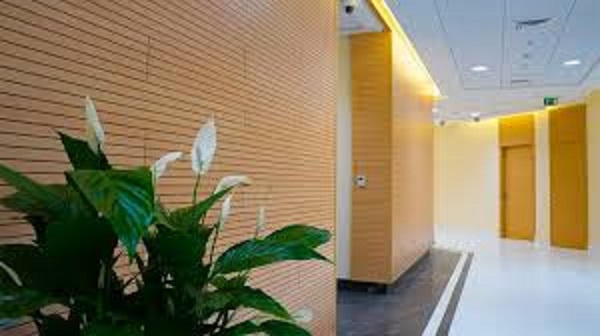In today’s fast-paced world, the spaces we inhabit are no longer just about walls, ceilings, and furniture, they are about how these elements interact to create experiences. One material leading the transformation of interiors across commercial, residential, and institutional projects is the acoustic wood panel wall system. What was once a niche product used mainly in high-end auditoriums and music rooms has now become a mainstream design element, finding its way into offices, restaurants, schools, hospitals, and even modern homes.
The design and construction industry is undergoing a major shift. Today, interiors are expected to deliver not only beauty but also wellness, performance, and sustainability. In this landscape, acoustic wood wall panels have emerged as a standout solution. Once considered niche, they are now in high demand across workplaces, hospitality, education, healthcare, and residential spaces.
Let’s look at the market trends driving the widespread adoption of acoustic wood panel wall systems worldwide.
1. Shift Toward Wellness-Centric Design
A key market trend shaping modern interiors is the emphasis on wellness. Companies and institutions are investing in environments that reduce stress, improve focus, and support overall wellbeing. Acoustic wood wall panels directly respond to this demand by controlling noise and creating balanced soundscapes.
2. Open Workplaces Needing Acoustic Control
The rise of open-plan offices and collaborative zones has amplified the need for effective sound solutions. Businesses are adopting acoustic timber panels to:
- Enhance speech clarity.
- Minimize noise disruptions.
- Support hybrid workspaces where focus and collaboration must coexist.
This workplace evolution has become a major growth driver for the acoustic panel market.
3. Hospitality Industry Redefining Guest Experience
Hotels, restaurants, and lounges increasingly view acoustics as part of their brand identity. Market demand is shifting toward interiors that balance energy with comfort. Designers are turning to acoustic wood wall panels and wood acoustic diffuser systems to craft immersive environments where sound complements ambiance.
4. Education Sector Modernization
Educational institutions worldwide are upgrading classrooms, libraries, and auditoriums with noise-control solutions. With learning outcomes tied closely to speech clarity, acoustic wood panel wall installations are becoming a standard feature in modern schools and universities.
5. Healthcare Spaces Prioritizing Comfort
Healthcare design trends are emphasizing healing environments. From patient rooms to consultation areas, noise reduction improves recovery and staff efficiency. Hospitals are integrating acoustic timber panels to achieve both acoustic comfort and clean, calming aesthetics.
6. Sustainability and Green Building Certifications
Market demand for sustainable materials is accelerating. Acoustic wood wall panels align with this trend as they can be manufactured from responsibly sourced timber, incorporate recyclable materials, and contribute to certifications like LEED and WELL. Sustainability is no longer optional—it’s an adoption driver.
7. Rise of Customization in Interiors
Another trend fueling adoption is customization. Clients want unique spaces that reflect their identity. Acoustic wood wall panels can be grooved, perforated, embossed, or finished in a wide range of colors and veneers. Many also double as a wood acoustic diffuser, offering performance while serving as a design statement.
8. Growth in Real Estate and Flexible Spaces
The expansion of commercial real estate and mixed-use developments is pushing the demand for versatile materials. Acoustic timber panels are widely used in multi-functional halls, co-working spaces, and premium residential projects where acoustic control adds value.
9. Technology-Driven Panel Systems
Innovations in acoustic wood wall panels—from modular designs to fire-rated options—are making them easier to install and more adaptable. This technological evolution aligns with market demand for quick, safe, and efficient construction solutions.
Rise of Sound-Conscious Spaces
Modern life is noisy. From open-plan offices to bustling restaurants and high-density urban living, noise pollution is one of the most underestimated challenges of our time. Studies suggest that excessive noise affects productivity, increases stress levels, and can even impact health. This rising awareness has created a surge in demand for materials that not only look good but also perform well on the acoustic wood panel wall.
Unlike conventional wall coverings, these panels are engineered to absorb and diffuse sound, ensuring balanced acoustics in a room. Whether it’s an office where concentration matters or a café where conversations should remain private, acoustic wood wall panels provide an intelligent solution that blends form with function.
Technology Integration in Acoustic Panels
Today’s acoustic wood panel wall solutions are not limited to traditional craftsmanship. Many are integrated with modern technology:
- Modular Systems: Easy-to-install panels that reduce construction time.
- Fire-Rated Materials: Panels designed to meet safety codes without compromising performance.
- Smart Acoustics: Panels engineered to perform differently in varying frequency ranges, creating tailored sound environments.
As clients demand smarter and faster solutions, the role of acoustic wood wall panels will only expand.
The Global Market Outlook
According to industry insights, the market for acoustic materials, especially acoustic timber panels, is projected to grow significantly over the next decade. The surge is fueled by:
- Rising urbanization and demand for quieter interiors.
- Growth of commercial real estate projects.
- Expanding hospitality and co-working sectors.
- A heightened focus on mental health and wellness in architecture.
With this momentum, wood acoustic diffuser technologies will likely become a standard feature rather than an optional luxury.
Conclusion: From Niche to Mainstream
The adoption of acoustic wood wall panels is being driven by clear market trends: wellness-centered design, the shift to open offices, hospitality’s focus on experience, modernization of education and healthcare, sustainability, customization, and real estate growth. These trends make acoustic timber panels and wood acoustic diffuser solutions not just a choice but a necessity in modern interior design.
Looking to align your projects with these global trends? Let’s bring innovation, wellness, and elegance into your spaces with our advanced acoustic wood panel wall and acoustic timber panel solutions.
Contact us today to explore custom acoustic solutions designed for the future of interiors.

